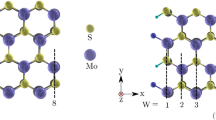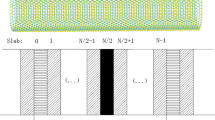Abstract
Using density functional theory calculations, we have investigated the mechanical properties and strain effects on the electronic structure and transport properties of molybdenum disulfide (MoS2) nanotubes. At a similar diameter, an armchair nanotube has a higher Young’s modulus and Poisson ratio than its zigzag counterpart due to the different orientations of Mo-S bond topologies. An increase in axial tensile strain leads to a progressive decrease in the band gap for both armchair and zigzag nanotubes. For armchair nanotube, however, there is a semiconductor-to-metal transition at the tensile strain of about 8%. For both armchair and zigzag nanotubes, the effective mass of a hole is uniformly larger than its electron counterpart, and is more sensitive to strain. Based on deformation potential theory, we have calculated the carrier mobilities of MoS2 nanotubes. It is found that the hole mobility is higher than its electron counterpart for armchair (6, 6) nanotube while the electron mobility is higher than its hole counterpart for zigzag (10, 0) nanotube. Our results highlight the tunable electronic properties of MoS2 nanotubes, promising for interesting applications in nanodevices, such as opto-electronics, photoluminescence, electronic switch and nanoscale strain sensor.

Similar content being viewed by others
References
Javey, A.; Guo, J.; Wang, Q.; Lundstrom, M.; Dai, H. J. Ballistic carbon nanotube field-effect transistors. Nature 2003, 424, 654–657.
Franklin, A. D.; Luisier, M.; Han, S. J.; Tulevski, G.; Breslin, C. M.; Gignac, L.; Lundstrom, M. S.; Haensch, W. Sub-10 nm carbon nanotube transistor. Nano Lett. 2012, 12, 758–762.
Appenzeller, J. Carbon nanotubes for high-performance electronics-progress and prospect. Proceedings of the IEEE 2008, 96, 201–211.
Shulaker, M. M.; Hills, G.; Patil, N.; Wei, H.; Chen, H. Y.; Wong, H. S. P.; Mitra, S. Carbon nanotube computer. Nature 2013, 501, 526–530.
Yan, L. Y.; Li, W. F.; Fan, X. F.; Wei, L.; Chen, Y.; Kuo, J. L.; Li, L. J.; Kwak, S. K.; Mu, Y. G.; Chan-Park, M. B. Enrichment of (8,4) single-walled carbon nanotubes through coextraction with heparin. Small 2009, 6, 110–118.
Yan, L. Y.; Li, W. F.; Mesgari, S.; Leong, S. S. J.; Chen, Y.; Loo, L. S.; Mu, Y. G.; Chan-Park, M. B. Use of a chondroitin sulfate isomer as an effective and removable dispersant of single-walled carbon nanotubes. Small 2011, 7, 2758–2768.
Yuan, W.; Li, W. F.; Mu, Y. G.; Chan-Park, M. B. Effect of side-chain structure of rigid polyimide dispersant on mechanical properties of single-walled carbon nanotube/cyanate ester composite. ACS Appl. Mater. Interfaces 2011, 3, 1702–1712.
Kis, A.; Mihailovic, D.; Remskar, M.; Mrzel, A.; Jesih, A.; Piwonski, I.; Kulik, A. J.; Benoît, W.; Forró, L. Shear and Young’s moduli of MoS2 nanotube ropes. Adv. Mater. 2003, 15, 733–736.
Remskar, M.; Mrzel, A.; Virsek, M.; Godec, M.; Krause, M.; Kolitsch, A.; Singh, A.; Seabaugh, A. The MoS2 nanotubes with defect-controlled electric properties. Nanoscale Res. Lett 2011, 6, 26.
Remskar, M.; Mrzel, A.; Skraba, Z.; Jesih, A.; Ceh, M.; Demšar, J.; Stadelmann, P.; Lévy, F.; Mihailovic, D. Selfassembly of subnanometer-diameter single-wall MoS2 nanotubes. Science 2001, 292, 479–481.
Seifert, G.; Terrones, H.; Terrones, M.; Jungnickel, G.; Frauenheim, T. Structure and electronic properties of MoS2 nanotubes. Phys. Rev. Lett. 2000, 85, 146–149.
Xu, L. Electronic structure of MoS2 nanotubes. Ph.D. Dissertation, Clemson University, Clemson, SC, USA, 2007.
Kuc, A.; Zibouche, N.; Heine, T. Influence of quantum confinement on the electronic structure of the transition metal sulfide TS2. Phys. Rev. B 2011, 83, 245213.
Mak, K. F.; Lee, C.; Hone, J.; Shan, J.; Heinz, T. F. Atomically thin MoS2: A new direct-gap semiconductor. Phys. Rev. Lett. 2010, 105, 136805.
Johari, P.; Shenoy, V. B. Tuning the electronic properties of semiconducting transition metal dichalcogenides by applying mechanical strains. ACS Nano 2012, 6, 5449–5456.
Yue, Q.; Kang, J.; Shao, Z. Z.; Zhang, X. A.; Chang, S. L.; Wang, G.; Qin, S. Q.; Li, J. B. Mechanical and electronic properties of monolayer MoS2 under elastic strain. Phys. Lett. A 2012, 376, 1166–1170.
Conley, H. J.; Wang, B.; Ziegler, J. I.; Haglund, R. F.; Pantelides, S. T.; Bolotin, K. I. Bandgap engineering of strained monolayer and bilayer MoS2. Nano Lett. 2013, 13, 3626–3630.
Heyd, R.; Charlier, A.; McRae, E. Uniaxial-stress effects on the electronic properties of carbon nanotubes. Phys. Rev. B 1997, 55, 6820.
Minot, E.; Yaish, Y.; Sazonova, V.; Park, J. Y.; Brink, M.; McEuen, P. L. Tuning carbon nanotube band gaps with strain. Phys. Rev. Lett. 2003, 90, 156401.
Kresse, G.; Furthmüller, J. Efficient iterative schemes for ab initio total-energy calculations using a plane-wave basis set. Phys. Rev. B 1996, 54, 11169–11186.
Kresse, G.; Furthmüller, J. Efficiency of ab-initio total energy calculations for metals and semiconductors using a plane-wave basis set. Comput. Mater. Sci. 1996, 6, 15–50.
Blochl, P. E. Projector augmented-wave method. Phys. Rev. B 1994, 50, 17953–17979.
Perdew, J. P.; Chevary, J. A.; Vosko, S. H.; Jackson, K. A.; Pederson, M. R.; Singh, D. J.; Fiolhais, C. Atoms, molecules, solids, and surfaces: Applications of the generalized gradient approximation for exchange and correlation. Phys. Rev. B 1992, 46, 6671–6687.
Li, W. F.; Zhao, M. W.; Zhao, X.; Xia, Y. Y.; Mu, Y. G. Hydrogen saturation stabilizes vacancy-induced ferromagnetic ordering in graphene. Phys. Chem. Chem. Phys. 2010, 12, 13699–13706.
Lorenz, T.; Teich, D.; Joswig, J. O.; Seifert, G. Theoretical study of the eechanical behavior of endividual TiS2 and MoS2 nanotubes. J. Phys. Chem. C 2012, 116, 11714–11721.
Bertolazzi, S.; Brivio, J.; Kis, A. Stretching and breaking of ultrathin MoS2. ACS Nano 2011, 5, 9703–9709.
Bardeen, J.; Shockley, W. Deformation potentials and mobilities in non-polar crystals. Phys. Rev. 1950, 80, 72–80.
Beleznay, F.; Bogár, F.; Ladik, J. Charge carrier mobility in quasi-one-dimensional systems: Application to a guanine stack. J. Chem. Phys. 2003, 119, 5690.
Long, M. Q.; Tang, L.; Wang, D.; Wang, L. J.; Shuai, Z. G. Theoretical predictions of size-dependent carrier mobility and polarity in graphene. J. Am. Chem. Soc. 2009, 131, 17728–17729.
Wang, J. Y.; Zhao, R. Q.; Yang, M. M.; Liu, Z. F.; Liu, Z. R. Inverse relationship between carrier mobility and bandgap in graphene. J. Chem. Phys. 2013, 138, 084701.
Long, M. Q.; Tang, L.; Wang, D.; Li, Y. G.; Shuai, Z. G. Electronic structure and carrier mobility in graphdiyne sheet and nanoribbons: Theoretical predictions. ACS Nano 2011, 5, 2593–2600.
Scalise, E.; Houssa, M.; Pourtois, G.; Afanas’ev, V.; Stesmans, A. Strain-induced semiconductor to metal transition in the two-dimensional honeycomb structure of MoS2. Nano Res. 2012, 5, 43–48.
Overney, G.; Zhong, W.; Tomanek, D. Structural rigidity and low frequency vibrational modes of long carbon tubules. Z. Phys. D 1993, 27, 93–96.
Yakobson, B. I.; Brabec, C.; Bernholc, J. Nanomechanics of carbon tubes: Instabilities beyond linear response. Phys. Rev. Lett. 1996, 76, 2511–2514.
Wong, E. W.; Sheehan, P. E.; Lieber, C. M. Nanobeam mechanics: Elasticity, strength, and toughness of nanorods and nanotubes. Science 1997, 277, 1971–1975.
Ding, Y.; Wang, Y. L.; Ni, J.; Shi, L.; Shi, S. Q.; Tang, W. H. First principles study of structural, vibrational and electronic properties of graphene-like MX2 (M = Mo, Nb, W, Ta; X = S, Se, Te) monolayers. Phys. B: Condens. Matter 2011, 406, 2254–2260.
Voß, D.; Krüger, P.; Mazur, A.; Pollmann, J. Atomic and electronic structure of WSe2 from ab initio theory: Bulk crystal and thin film systems. Phys. Rev. B 1999, 60, 14311–14317.
Albe, K.; Klein, A. Density-functional-theory calculations of electronic band structure of single-crystal and singlelayer WS2. Phys. Rev. B 2002, 66, 073413.
Han, S. W.; Kwon, H.; Kim, S. K.; Ryu, S.; Yun, W. S.; Kim, D. H.; Hwang, J. H.; Kang, J. S.; Baik, J.; Shin, H. J.; Hong, S. C. Band-gap transition induced by interlayer van der Waals interaction in MoS2. Phys. Rev. B 2011, 84, 045409.
Zibouche, N.; Kuc, A.; Heine, T. From layers to nanotubes: Transition metal disulfides TMS2. Eur. Phys. J. B 2012, 85, 1–7.
Author information
Authors and Affiliations
Corresponding author
Electronic supplementary material
Rights and permissions
About this article
Cite this article
Li, W., Zhang, G., Guo, M. et al. Strain-tunable electronic and transport properties of MoS2 nanotubes. Nano Res. 7, 518–527 (2014). https://doi.org/10.1007/s12274-014-0418-y
Received:
Revised:
Accepted:
Published:
Issue Date:
DOI: https://doi.org/10.1007/s12274-014-0418-y




